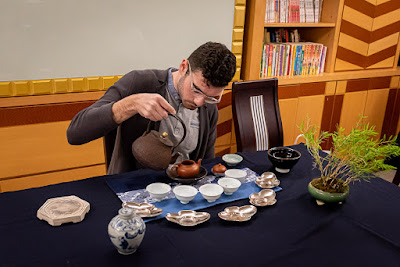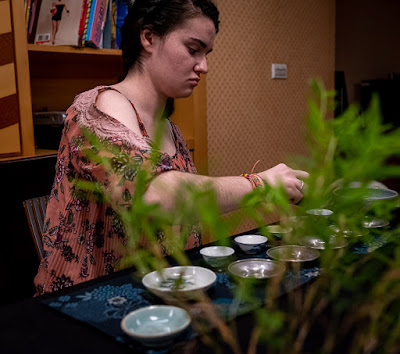The 9 students from Penn State who came to Taiwan around the New Year received a very broad and diverse range of tea classes. I already wrote about the Chaxi and Oolong, Outdoor brewing, puerh time machine classes below. They also had a glimpse into Teaparker's newest Tea Sommelier courses.
It started with a 3 hours class at the Landis Hotel and was followed by a dinner at the hotel's Chinese Jiangzi restaurant, Tian Xiang Lo. During the dinner, they practiced the theory of tea and food pairing.
Here is what Borb wrote about this experience: "The jassid-bitten oolong that was served first was characteristically sweet, almost like syrup, and had a muted but round dark flavor similar to roasted walnuts. It felt thin like ink and coated the entire mouth. These attributes caused it to pair best, in my opinion, with the eel, fried chicken, and the fried noodle dish we were served last. The honey notes mixed well with the dryness that the food left in the mouth and what spices there were on the food (or sauces in the case of the desert) were not overpowering. I was left with a sensation of clarity and cleanliness in the mouth as well as the echo of the tea’s sweetness. It reminded me of the way after a bell was rung the tone lingers longer than you can properly hear it. This tea also paired well with the vegetable meal because of the sweetness of the oil. It was washed out in the same way as the above fried foods."
We also paired other dishes with a roasted Oolong and with a young gushu puerh. Not all the pairings worked well. But when they worked there was a broad agreement among the students that the tea added something to the food and that the food also added something to the tea! This showed that tea pairing is not a concept that is subjective and personal, but that there's a logic of why a certain tea would go well with certain type of food.
This is what I have been learning with Teaparker in December and early January. The PSU students could come and witness the final exam of the International Tea Sommelier Training on January 7th, 2000. Two outside food and tea experts came to judge our food and tea pairings.
I chose the Stir Fried Pearl Peas with Chicken from the Michelin star restaurant Tian Xiang Lo and paired it with my spring 2019 Da Yu Ling high mountain Oolong. The idea for this combination was to serve one of Taiwan's best Oolong, coming from one of its highest plantations, and pair it with a dish prepared by one of Taipei's landmark restaurant. The pairing should go well, because Da Yu Ling has light spring flavors that resonate with the light flavors of chicken and the spring, green feeling of peas.
Apparently, my focused attitude while brewing and the tea combined with the dish must have convinced the jurors. At the end of the exam, I received a good feedback of the professional food critique (in white): she felt impressed by the finesse and delicate taste of this pairing. And, in the meantime, Teaparker has informed me that I have obtained the highest total score of all the students in this Tea Sommelier training (where the final exam had a 50% weight)! I had always been a 'good' student with high marks during all my school life, but it's the first time I actually finish No. 1, top of my class! At 48, it was a long wait, but it feels even more sweet. But I'm not going to rest on my laurels. There's so much more to learn with tea... It just feels good to be able to share this added experience with others who are interested to learn!
Tomorrow, the Chinese New Year vacation will start. I will still process the orders received before 8 PM US Eastern time today. Otherwise, the next deliveries will start on January 30th again. Below are the new postcards that I have made following your votes for my best pictures of 2019! (All physical orders always include 1 or 2 exclusive tea postcards!)
Water shock
1 day ago






































































